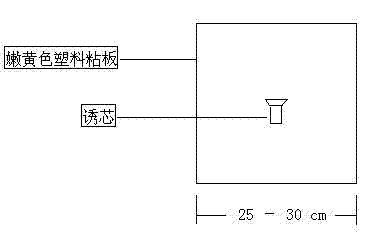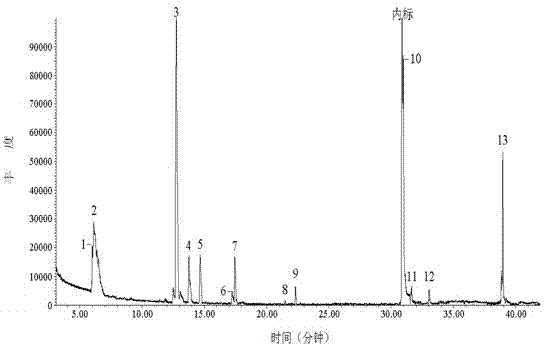Method for preventing and controlling empoasca vitis by trapping
A false-eye small green leafhopper and trapping technology is applied in the fields of pest control, botanical equipment and methods, devices for capturing or killing insects, etc. Quick effect, easy operation, reduce the effect of chemical control
- Summary
- Abstract
- Description
- Claims
- Application Information
AI Technical Summary
Problems solved by technology
Method used
Image
Examples
Embodiment 1
[0018] (1) Choose healthy tea tree plants as the test material, cover with a clean glass cover, and pass clean air from the air inlet, with the tea tree smell flowing through the Super Q adsorption column connected to the air outlet, and rinse the adsorption column with chromatographic pure ether. The eluent is slowly concentrated under a stream of high-purity nitrogen. The concentrated liquid was analyzed by gas-mass spectrometry, qualitatively matched with standard samples, and quantified by adding internal standard ethyl decanoate to identify 13 main components in the smell of tea trees;
[0019] (2) Using the 3rd instar green leafhopper nymphs as test insects, the 13 main components identified, pentanol and phenethyl alcohol were used as taste sources, and behavioral bioassays were carried out by Y-shaped olfactory. Indicates: amyl alcohol, -Ocimene, phenethyl alcohol, and trans-2-hexenal are the most attractive to small green leafhoppers with false eyes. Allocate these 4 g...
Embodiment 2
[0027] (1) Isolate and identify healthy whole tea plant volatiles and test their attractant activity to leafhoppers
[0028] Cover the ground part of the potted Longjing tea tree plant with a clean glass cover, and pass in filtered clean air from the air inlet, entraining the tea tree odor through the Super Q adsorption column connected to the air outlet, dynamically adsorbing 8 After 10 hours, remove the adsorption column and rinse with chromatographic pure ether. The eluent is slowly concentrated to about 20μl under a stream of high-purity nitrogen. Aspirate 1μl, analyze by GC-MS, qualitatively match with standard samples, add internal standard ethyl caprate for quantification, and identify 13 main components in the smell of tea tree, see figure 2 . figure 2 Middle: 1 is trans-2-hexenal ( E )-2-hexenal, 2 is cis-3-hexen-1-ol ( Z )-3-hexen-1-ol, 3 is cis-3-hexene acetate ( Z )-3-hexenyl acetate, 4 is 2-ethylhexanol 2-ethyl-1-hexanol, 5 is -Ocimene -ocimene, 6 is linalool, 7...
Embodiment 3
[0052] For many years, the tea gardens of Gengxiang Organic Tea Company in Wuyi County, Zhejiang Province have banned chemical pesticides. Usually, at the end of spring tea in mid-May, the tea gardens are re-pruned and the branches and leaves are cut to suppress the first leafhopper population, and the second in September. Plant and mineral pesticides are used when leafhopper populations are in full bloom. The pollution-free tea gardens surrounding its company have been using chemical pesticides. Do the following control tests:
[0053] (1) Entrapment test In 2010, the research group selected the company's leafhopper density to reach the control target, with an area of 6700 m 2 The tea plantations are used as trapping areas and are not trimmed. Regular field surveys showed that June 4 was the first season for leafhopper adults, that is, the number of adult leafhoppers accounted for 16% of the total leafhopper population. Then the new trap was loaded on a rubber head to mak...
PUM
 Login to View More
Login to View More Abstract
Description
Claims
Application Information
 Login to View More
Login to View More - R&D
- Intellectual Property
- Life Sciences
- Materials
- Tech Scout
- Unparalleled Data Quality
- Higher Quality Content
- 60% Fewer Hallucinations
Browse by: Latest US Patents, China's latest patents, Technical Efficacy Thesaurus, Application Domain, Technology Topic, Popular Technical Reports.
© 2025 PatSnap. All rights reserved.Legal|Privacy policy|Modern Slavery Act Transparency Statement|Sitemap|About US| Contact US: help@patsnap.com



